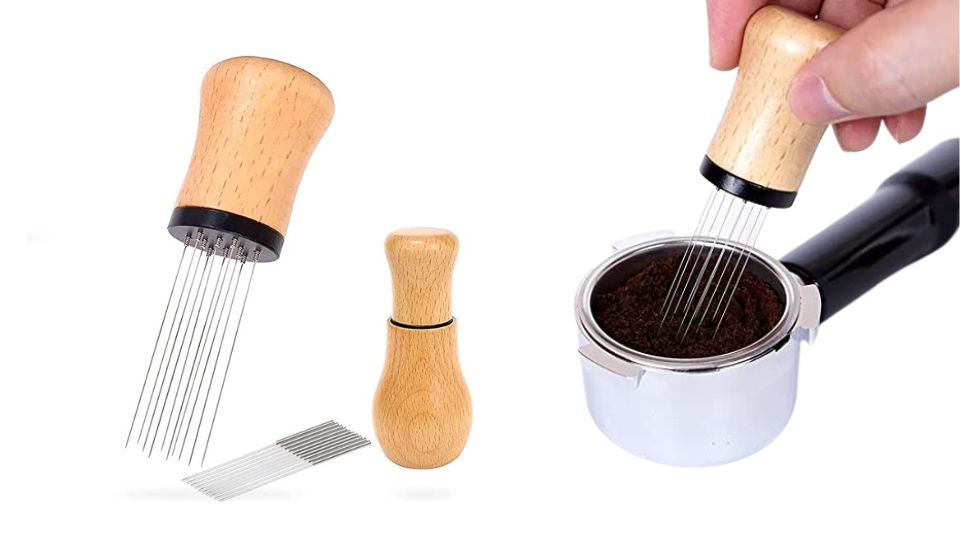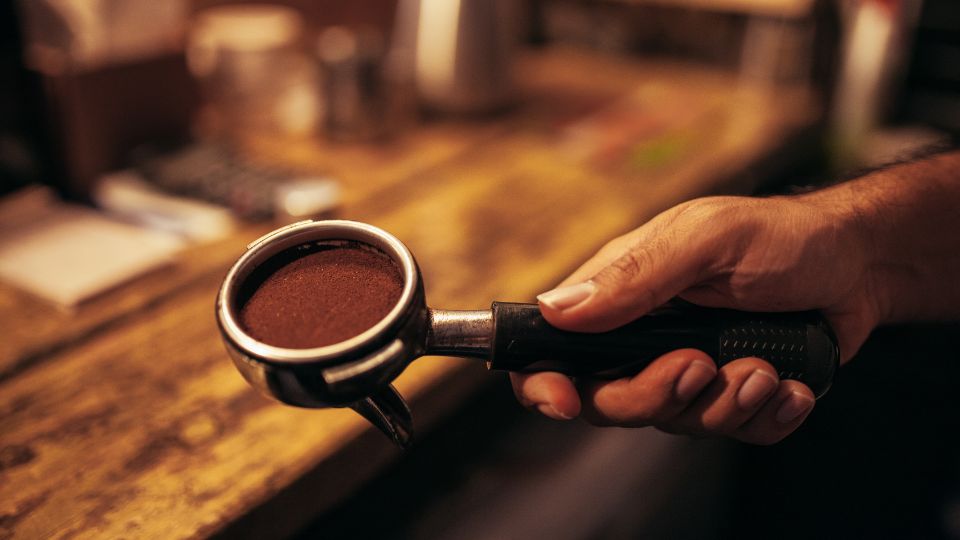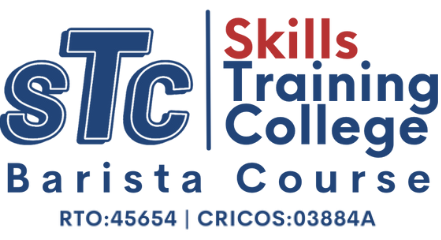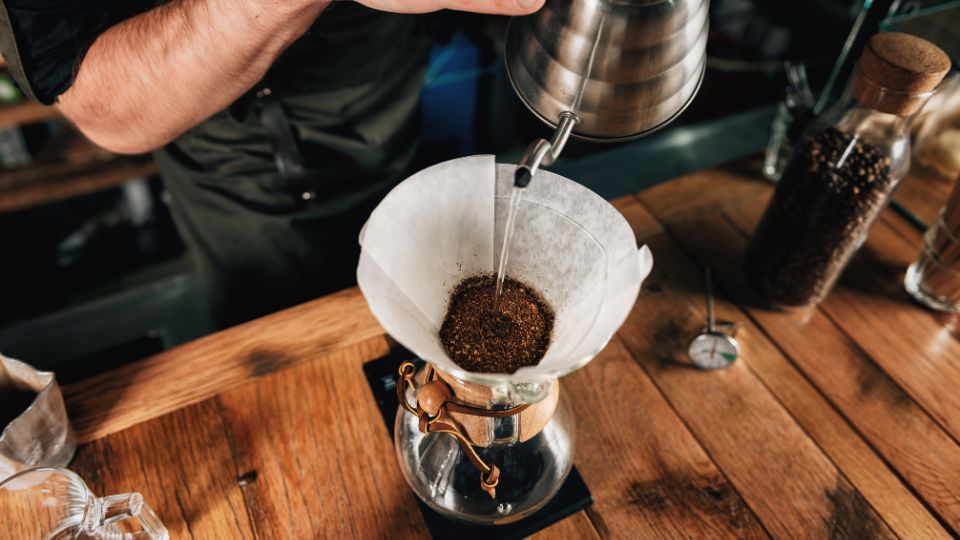When brewing the perfect cup of coffee, agitation is crucial. Professional baristas often prefer the pour-over method for its thorough saturation of coffee grounds, leading to better extraction and a tastier cup of coffee. There are various ways to achieve saturation, but the Wet Weiss method is an exciting and innovative option that sets itself apart.
The Weiss Distribution Tool (WDT) is a mini whisk-like tool designed to distribute espresso grounds. Still, it can also agitate pour-over coffee for an evenly saturated bed resulting in improved extraction and flavour.
For an unparalleled coffee adventure, it is crucial to stir the coffee grounds during the blooming stage and after the first pour. This will elevate your coffee game and take your taste buds on a thrilling ride. This can be easily done with the WDT, which helps to release any trapped air and results in a perfect cup of coffee.
This innovative espresso distribution tool promises to elevate your coffee experience, bringing it to a new level of excitement. So let’s delve deeper and uncover the secrets to brewing the perfect cup of coffee.
What Is The Key To A Perfectly Brewed Coffee?
The key to a perfectly brewed cup lies in the bloom – the initial step that ensures a smooth and consistent extraction.
When water meets dry coffee grounds, the hydraulic resistance drops significantly in the wet area, allowing the water to flow through the coffee bed effortlessly. Thanks to capillary action, the water spreads evenly in all directions.
To speed up the blooming process and achieve a more balanced extraction, use a WDT tool to stir your coffee bed. This nifty gadget ensures that all the grounds get wet, resulting in a more delicious and satisfying cup of coffee. Get ready to experience the perfect brew every time!
Why Is It Vital To Agitate The Coffee Bed?
When coffee blooms, it releases gases that can affect the extraction process. Some of this gas escapes the coffee bed, while the rest remains, creating bubbles that can cause uneven extraction. To avoid this, agitating the coffee bed before and after pouring is crucial.
This helps release the trapped gas, which can hinder the water from flowing evenly through the coffee bed. The agitation also helps the fine coffee particles to stay uniform and prevents clogging in the filter. So, you can enjoy a more even and exciting coffee experience with proper agitation and extraction.

Who Is the WDT Method Creator?
WDT is the abbreviation for “Weiss Distribution Technique.” The method (WDT coffee) is named for John Weiss, who developed the technique back in 2005 as a way to compensate for grinders, especially smaller home grinders, that produced excessive clumps.
What Is The WDT Espresso Method?
The Weiss Distribution Technique (WDT) is a popular method of distributing coffee grounds while making espresso. In this technique, the barista uses a fine needle or a similar tool to stir the coffee in the portafilter.
The stirring action helps break up clumps and ensures the coffee is evenly distributed within the puck. As a result of this technique, channeling is reduced, and higher and more even extractions are obtained.
The WDT was initially developed to compensate for poor-quality grinders, especially smaller home grinders that produced excessive clumping. Over the years, the technique gained popularity among home baristas and has been extensively written about.
Although commercial and ‘prosumer’ grinders nowadays include features designed to break up large clumps and distribute the coffee more evenly, recent studies suggest more is needed to achieve the best-tasting espresso.
However, with the advent of pressure or flow-profiling machines like the Crem One LFPP and the Decent machines, the WDT has come into the spotlight again. By analysing the pressure and flow inside the puck, we can determine which techniques produce a more stable puck and which cause micro-channelling. This analysis has shown that the WDT does make a significant difference when used.
 Weiss Distribution Technique
Weiss Distribution Technique
The following are step-by-step instructions for the Weiss Distribution technique:
- Insert a funnel into the portafilter’s top opening. You can avoid a mess by doing it this way.
- To begin, locate one of the portafilter’s edges. Continue to move around in a circling fashion around the basket until you have completed a full revolution. The depth must be relatively near the base of the basket.
- Complete the task by making a series of little circular motions in the middle of the area.
- Your finished product should have a little puffy yet even appearance.
- Give the portafilter a light tap on the counter from below to ensure the grounds are packed vertically.
- And then it’s time to tamp and brew.
What Are Different Types Of Weiss Distribution Tools (WDT)?
A dissecting needle was John Weiss’s first suggestion for the WDT Tool. The skinny needle and good handle worked perfectly together. Nonetheless, many different designs have been developed since then.
While the single needle is still used by certain coffee enthusiasts, versions with three to nine needles are much more commonplace. Some of the most common tools are:
- Common Weiss Distribution Technique Tool: The standard WDT tool usually consists of a holder and three to five thin needles that are fixed onto it. The holder can be made from either real wood or plastic that has been 3D printed.
Generally speaking, 0.2 mm to 0.4 mm diameter needles work well. Thicker needles will compress the tiny grinds more, leading to increased clumping and channelling, negating the tool’s intended purpose.
- Needle Distribution Tool: This tool has features from a WDT and a wedge distribution instrument. Turning it on top of the portafilter basket disperses the needles and prevents clumping.
The tool can keep the needles at a considerable depth into the ground. If you use an OCD-style wedge distributor, the grounds can be tamped without further distribution. One major drawback of the device is the price.
- WDT With A Looped End: This is an alternative to the conventional WDT in which the end is looped. But, industry professionals warn against doing so since it causes more clumping in the coffee. Sharp-pointed needles deliver better outcomes.
- WDT Tool DIY: Making your own wdt tool is a cheap and fun DIY project. You can use acupuncture needles and a wine bottle cork to do this. The holder’s files can be downloaded for free if you can access a 3D printer.
Be sure to double-check the needle sizes you’re working with. They should be no thicker than a dissecting needle and ideally much thinner. Home baristas have used toothpicks and paper clips as makeshift WDT tools. However, these implements must be thicker and contribute to clumping rather than facilitating removal.
Humidity In Espresso
Coffee stored in high humidity produces a smaller bloom and a faster flow rate in a V60 than in low humidity. Due to its increased moisture content, coffee is cooled with water after roasting degasses more rapidly than air-cooled coffee.
A much finer grind setting is required to get decent shot timings when using humidified coffee. As a result, the shots produced had a lot less crema. All of this shows that degassing is important in how humidity affects espresso. This shows the importance of degassing in determining how humidity affects espresso.
When grinding beans, humidity also impacts the particles generated since moist beans are less fragile than dry beans. Thus, the shot time of wet beans necessitates a more finely ground setting on the grinder.
Barriers To The Puck’s Flow Rate
How can the pucks’ flow rates be so different if there is no apparent structural difference between them? The hydrophobic properties of dry coffee and the gases trapped within the granules are probable explanations.
The hydrophobic nature of dry coffee makes it naturally resistant to water flow. This is analogous to the first few minutes after watering a fully dry houseplant in a pot when the water collects on the surface or runs off. Only after the soil is already damp can the remaining water be absorbed.
Gases trapped inside dry coffee may also prevent water from penetrating the puck. Since it has a higher concentration of gases that are more difficult to release, freshly roasted coffee requires a coarser grind than coffee stored for a long time.
What Is The Science Of Wet Weiss And Jamming, And How Is It Related To Coffee?
In physics, “jamming” describes how some fluids or fluid-like substances, particularly powders, become more viscous at increased densities. The fluid experiences a phase change as the density rises and the particles become closer. The particles are so closely packed at this point that the material behaves like a solid rather than a liquid.
Consider pouring a stream of sand onto a flat surface to visualise this transition. The sand acts like a liquid when poured. However, it forms a pile rather than spreads like a liquid when it reaches the surface. Due to the pull of gravity, the sand has packed tightly and is now behaving like a solid.
Let’s examine the science of “jamming” and how it relates to coffee. Jamming describes how particles, such as powdered coffee, can create structures that resist pressures applied to them, such as tamping. Loose particles can flow in the same way as liquids do. Under some conditions, powder particles can form structures like arches that ‘jam’ or impede the flow.
The same concept governs how tightly coffee can be packed in an espresso puck. When you tamp the ground coffee, it compresses until the particles connect and become jammed. Tamping harder after that has little influence on the structure of the puck.
In many cases, adding water helps to break up jams. Anyone who has tried to pour damp salt out of a shaker knows that even a small amount of water can generate “capillary bridges” and cause particles to stay together. When a large amount of water is added, such as when producing cement, it transforms into a plasticiser. A plasticiser prevents particles from adhering to one another, allowing them to flow more freely.
Coffee’s cell walls become more flexible when wet, allowing the particles to deform more easily under the influence of water. This would help the tamping force break up a jam in the ground coffee.
We could make a dense coffee puck if we soaked it in water first.

The Wet Tamping Challenge
Tamping wet coffee without it sticking to the puck is the first obstacle to overcome. The best remedy is to cover the damp coffee with cling film. Mix ground coffee with hot water in a mug, then use the Comb WDT to combine the two liquids thoroughly. After redistributing the coffee evenly with the Comb, pour it into a portafilter basket and tamp it down.
Once the coffee has been tamped, carefully remove the cling wrap to reveal a moist, tamped puck. Now that this problem has been solved, start pulling shots. Suppose you’re having trouble with wet tamping. Consider the prolonged contact time between the water and coffee when preparing espressos. Then stir the wet coffee before trying again.
DO COFFEE HOUSES NEED WEISS DISTRIBUTION TECHNIQUE DEVICES?
The Wet Weiss method is an efficient way to eliminate of the layer that appears to contain trapped gases. You can see the coffee bed getting darker, and there is no longer any sign of a bubble within it. The Wet Weiss technique not only leads to higher extraction but also enhances the flavour of the brews.
It’s expected that baristas know how to tamp properly; employing the WDT can further ensure uniformity. Baristas would be able to provide higher-quality beverages if they used the WDT appropriately, which would allow for more uniform extraction. If you’re interested in learning more about how to use this method to enhance the flavours of the brew, your best bet is to find an accredited training provider.

